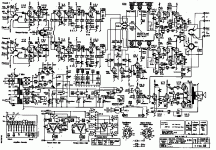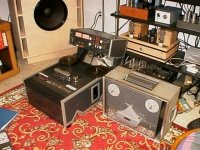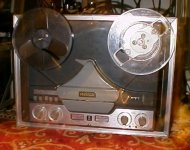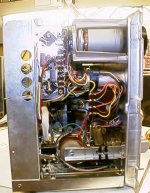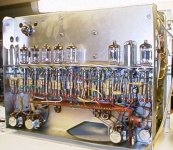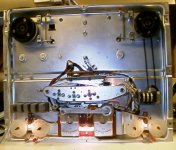I resurrected an old thread on the revox, so far the only responses have been to the original post from over 3yrs ago so I will not make that mistake again. 
Anyway this fairly nice ReVox G36 MKIII 117V North American edition half track recorder fell into my lap recently and although I have worked on many of these decks and am relatively comfortable working on it, it has been a long time since the last one.
Long enough that although the selenium rectifiers and electrolytics all test good I seriously think I should without question replace them. Seems logical except that the design is so efficient that I will have to make significant changes to get voltages right. The only source of drop in replacement caps (vibroworld) seems to be gone, and no one seems to be able to tell me whether most decks still running are still using the stock supply components. Realistically at 42yrs out I would assume this is skirting disaster.. It's just that this deck is virgin and I want to do the updates with comparable parts that don't leave it looking like a hack worked on it.
This machine seems to be a low hours unit and hence should have a long remaining service life with care.
I'm also planning on some mods. Charlie King recommends removing the 5W PP amplifier which makes sense as this generates most of the heat in the electronics section due to its dissipation.
In addition the current input amplifier provides far too much gain with modern sources and basically I don't need it at all. I plan to just go right in at the recording level control. I could eliminate a further two tubes doing this if I so choose, but this would require modifying the dc filament supply. (Probably a performance enhancement actually)
I've replaced a couple of electrolytics in the replay electronics.
I have not yet run the deck, but I am told this is a high speed version. (7.5ips/15ips) I have not been able to prove or disprove this.. I have 15ips recorded tapes so that will be the acid test once I get it powered up.
Anyone have a guess as to what type of caps the motor phase shift caps are, and whether I should replace/rebuild (new caps in old cans?) On older versions these actually can present an electrical hazard due to leakage into the chassis. The 117V version runs the motors off of a dedicated winding on the power transformer and the motor circuitry is fully isolated from the mains.
I've provided a schematic of my version for the curious or helpful.
I'm really looking for insights, comments, advice and encouragement from people who are still working on these decks.

Anyway this fairly nice ReVox G36 MKIII 117V North American edition half track recorder fell into my lap recently and although I have worked on many of these decks and am relatively comfortable working on it, it has been a long time since the last one.
Long enough that although the selenium rectifiers and electrolytics all test good I seriously think I should without question replace them. Seems logical except that the design is so efficient that I will have to make significant changes to get voltages right. The only source of drop in replacement caps (vibroworld) seems to be gone, and no one seems to be able to tell me whether most decks still running are still using the stock supply components. Realistically at 42yrs out I would assume this is skirting disaster.. It's just that this deck is virgin and I want to do the updates with comparable parts that don't leave it looking like a hack worked on it.
This machine seems to be a low hours unit and hence should have a long remaining service life with care.
I'm also planning on some mods. Charlie King recommends removing the 5W PP amplifier which makes sense as this generates most of the heat in the electronics section due to its dissipation.
In addition the current input amplifier provides far too much gain with modern sources and basically I don't need it at all. I plan to just go right in at the recording level control. I could eliminate a further two tubes doing this if I so choose, but this would require modifying the dc filament supply. (Probably a performance enhancement actually)
I've replaced a couple of electrolytics in the replay electronics.
I have not yet run the deck, but I am told this is a high speed version. (7.5ips/15ips) I have not been able to prove or disprove this.. I have 15ips recorded tapes so that will be the acid test once I get it powered up.
Anyone have a guess as to what type of caps the motor phase shift caps are, and whether I should replace/rebuild (new caps in old cans?) On older versions these actually can present an electrical hazard due to leakage into the chassis. The 117V version runs the motors off of a dedicated winding on the power transformer and the motor circuitry is fully isolated from the mains.
I've provided a schematic of my version for the curious or helpful.
I'm really looking for insights, comments, advice and encouragement from people who are still working on these decks.
Attachments
Horexx said:
Thanks, I've seen it, and read it.. Really looking for recent direct experience..
EC8010 said:I'm wondering why anyone would refurbish a Revox G36. After all, the transport is nothing to write home about. Why not refurbish a (professional) Studer A80 or later?
I'm not sure I can give a rational answer that question as I also have an Otari MX-55-T-M studio recorder which is quite nice.
I'll try though..
I was hoping it was the rarer 15ips version, but it's not. I may look for a high speed capstan assembly at some point. (Why won't the site allow the legitimate abbreviation for assembly??) Parts are not too hard to get. They sound good when working properly? Emotional attraction - I've wanted one since I was 17..
I'm not sure exactly what your objections to the transport are, for its day it was about the only commonly available consumer deck with 3 motors and a direct drive capstan available here in N.A. I think that makes it notable, and worthwhile compared to any single motor deck out there. Performance numbers for wow & flutter are respectable and generally better than the specs would indicate. The heads are decent performers, but far better heads are available and can be installed. For my planned usage the stock heads are more than good enough.
These old ReVox machines are the only vintage recorders other than later Ferrographs, and Ampex 350 series gear that I have any interest in. Certainly not sota, but far far better than most vintage Japanese consumer grade decks for the same sort of money.
Not sure what is going on in regards to tape on your side of the pond, but there has been quite a renaissance in interest in open reel tape and the machines to play them here. Enough that I am taking notice.
My objection is very simple; you can pick up a real studio machine with real (and reel) servos, capstan servo etc for the same as a G36. In fact, broadcasters give them away. The Studer A80 is a beautifully engineered machine and built like a battleship. Unfortunately, it takes up almost as much room...
The A80 is a monstrous machine, you need two people to move it around, not practical at all. The portable recorder is less problem. Remove the tubes you mentioned, replace the electrolytics, and if it's ok leave the selenium rectifier alone. Your idea to go directly in to the level control is a good one. The motor capacitors are not electrolytics ,so they are still ok. Good luck. Miklos
EC8010 said:My objection is very simple; you can pick up a real studio machine with real (and reel) servos, capstan servo etc for the same as a G36. In fact, broadcasters give them away. The Studer A80 is a beautifully engineered machine and built like a battleship. Unfortunately, it takes up almost as much room...
Yeah, I have a friend who has one, it's just way too large for my listening room..
The G36 landed in my lap and I have literally nothing in it but a few hours of my time.
My objection is very simple; you can pick up a real studio machine with real (and reel) servos, capstan servo etc for the same as a G36. In fact, broadcasters give them away.
Hi -
Have any contact info for these broadcasters?
thoriated said:
Hi -
Have any contact info for these broadcasters?
IMO A good question.. I do have a friend who has one of these decks and it is huge. I might have gotten this deck as an option, but honestly I doubt I could even get it down the stairs into my audio lair/workshop/man cave...

 IIRC I think this thing can take at least 14" reels and is about a yard (or more) across. It is HUGE.. Not home friendly unless you have a really big place.
IIRC I think this thing can take at least 14" reels and is about a yard (or more) across. It is HUGE.. Not home friendly unless you have a really big place.The few broadcast facilities I have seen around here had mostly Ampex gear, so I suspect the A80 while not totally unusual would be somewhat less common. You can find a lot of good recorders on eBay, question is how well the seller will pack them.
A friend of mine has bought 3 Lyrecs simply because he wanted one. The first was destroyed in shipping, the second had trashed heads, and hopefully the third will be the charm.
Most recorders sold here in the "good old days" were single motor types with 2 or 3 heads, and have relatively poor performance particularly in regards to flutter. (not scrape flutter, but actual flutter..
Well to get back to the topic of this thread, I did get the machine running last night, and all mechanical functions and the transport work perfectly. I did have to tinker with the tape tension switch as someone had messed with it, but I got it going. I also had to replace the 100 ohm 10W (really 5W) tape tension resistor - this is used with 7" reels and below and bypassed for 10.5" reels and above. (Yes it will take a DIN reel.)
Playback is fine, no odd noises and it sounds ok on material recorded on the other machine.
The right channel records fine, the left channel is intermittent. I suspect a bad/dirty contact.
I completely disconnected the monitor amplifier and removed the output transformer and speaker. I modified the optical tape sensor circuit to run off of a higher supply voltage, (133K in place of the 100K on the optical board) changed the 2.2K resistor to the oscillator and record amp from 2.2K to 12K and moved the connections for them both to the highest voltage taps on the supply. All voltages are within about 5% of where they were before, and the voltage regulation to the rest of the electronics is slightly improved by the change which was inspired by Charlie King's article in Glass Audio's first issue.
Playback is fine, no odd noises and it sounds ok on material recorded on the other machine.
The right channel records fine, the left channel is intermittent. I suspect a bad/dirty contact.
I completely disconnected the monitor amplifier and removed the output transformer and speaker. I modified the optical tape sensor circuit to run off of a higher supply voltage, (133K in place of the 100K on the optical board) changed the 2.2K resistor to the oscillator and record amp from 2.2K to 12K and moved the connections for them both to the highest voltage taps on the supply. All voltages are within about 5% of where they were before, and the voltage regulation to the rest of the electronics is slightly improved by the change which was inspired by Charlie King's article in Glass Audio's first issue.
I have 2 G36s and i still like them very much - one without heads, so it's dormant - new heads just too costly for me right now.
They outclass the far east machines of the time by a big margin.
Sizewise they are big enough to be solid and confidence-inspiring, yet still carryable. My ampexes are impossible to move, so get used much less.
The G36 amplifiers are good, and i don't see any need to mess with them - the tube sockets need attention though for corrosion.
I replaced the pushbutton switch assembly (which broke irrepairibly) on one with relays - when i didn't know about electronics. I think I may go in and give it a microprocessor and triacs someday soon.
I also modified the monitoring switching to be more like the B77 - though I want to change that back, to be original.
I'd also like to get it up to 15ips, and wondered if one could run the motor at 100Hz (120Hz for the USA capstan).
I know these machines used to present problems getting up to speed on 7.5 IPS when cold - the motor is not torquey enough, and 15ips would be even more of a load on the motor with the bigger capstan.
They outclass the far east machines of the time by a big margin.
Sizewise they are big enough to be solid and confidence-inspiring, yet still carryable. My ampexes are impossible to move, so get used much less.
The G36 amplifiers are good, and i don't see any need to mess with them - the tube sockets need attention though for corrosion.
I replaced the pushbutton switch assembly (which broke irrepairibly) on one with relays - when i didn't know about electronics. I think I may go in and give it a microprocessor and triacs someday soon.
I also modified the monitoring switching to be more like the B77 - though I want to change that back, to be original.
I'd also like to get it up to 15ips, and wondered if one could run the motor at 100Hz (120Hz for the USA capstan).
I know these machines used to present problems getting up to speed on 7.5 IPS when cold - the motor is not torquey enough, and 15ips would be even more of a load on the motor with the bigger capstan.
I did some work on the record amplifiers and the signals seem to be clean to the traps anyway..
Playback on the left channel now appears to be malfunctioning..
A little progress and some setbacks along the way. I will probably have to remove it from its case yet again when I next work on it.
Here's a picture of my Otari and the ReVox next to it.
There was a higher speed/higher torque motor for 15ips operation on 50Hz, for 60Hz I think the only recourse is a capstan assembly change. I can imagine the cold speed issue might well be a problem in cold weather around here. I encountered it on a machine I worked on when the issue was not well publicized..
The eagle eyed might just barely notice that the Otari is in record mode and is in fact doing a dub from a cd to tape.
Playback on the left channel now appears to be malfunctioning..
A little progress and some setbacks along the way. I will probably have to remove it from its case yet again when I next work on it.
Here's a picture of my Otari and the ReVox next to it.
There was a higher speed/higher torque motor for 15ips operation on 50Hz, for 60Hz I think the only recourse is a capstan assembly change. I can imagine the cold speed issue might well be a problem in cold weather around here. I encountered it on a machine I worked on when the issue was not well publicized..
The eagle eyed might just barely notice that the Otari is in record mode and is in fact doing a dub from a cd to tape.
Attachments
Here's another picture.. It's actually playing in this one. (not well though on one channel...  )
)
The transport is working fine, I fixed a minor problem with the tape tension switch and also replaced the 100 ohm power resistor across its contacts. The solder short across the switch initially lead me to believe the switch was bad - it was, later fixed, but the power resistor was open. This was probably due to it being a 5W type when it really needed to be 10W. The new one is a series string of 4 x 25 ohm 5 W from my bins and has a ~20W rating. It gets quite warm in operation.
The optical tape path sensor works way better than the old switch/wire arm set ups of the MKI and MKII...
 )
)The transport is working fine, I fixed a minor problem with the tape tension switch and also replaced the 100 ohm power resistor across its contacts. The solder short across the switch initially lead me to believe the switch was bad - it was, later fixed, but the power resistor was open. This was probably due to it being a 5W type when it really needed to be 10W. The new one is a series string of 4 x 25 ohm 5 W from my bins and has a ~20W rating. It gets quite warm in operation.
The optical tape path sensor works way better than the old switch/wire arm set ups of the MKI and MKII...
Attachments
Spent some more time last night on the deck, measured all of the dc voltages on every pin of every tube in the playback amplifier.. Everything seems to be in order, but I did not have time to run a tape and use my scope to see what is actually going on in the ac domain. All I can say is that I see no particular reason why the left channel does not play back correctly.. Dollars to donuts it will probably turn out to be a bad coupling cap. The caps are those mustard yellow Mullard things, and none are leaky, but that does not mean there isn't one open somewhere. (Hoping it is not the head.)
To measure voltages I've been using a Hickok made diagnostic socket with contacts that I can probe as a lot of the circuitry cannot be directly reached because of the design of the amplifier assembly.
I cleaned the tube sockets last night as well, hope to run a pre-recorded tape as well as one recorded on the Otari and see what happens tomorrow evening.
To measure voltages I've been using a Hickok made diagnostic socket with contacts that I can probe as a lot of the circuitry cannot be directly reached because of the design of the amplifier assembly.
I cleaned the tube sockets last night as well, hope to run a pre-recorded tape as well as one recorded on the Otari and see what happens tomorrow evening.
Steerpike said:
They outclass the far east machines of the time by a big margin.
You might kill me for saying this but the G36 MKIII with new heads is no match to the Sony TC-777 made in the same era.
Back in the 1960s the MSRP of TC-777 was $700, while the G36 was only $500. Remember back then 300 yen = US$1
- Home
- Source & Line
- Analogue Source
- Restoring ReVox G36 MKIII - Expert Opinions Solicited
